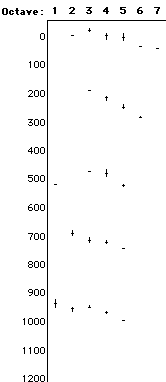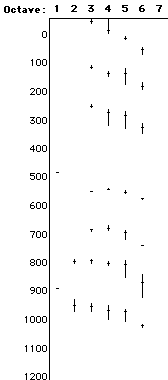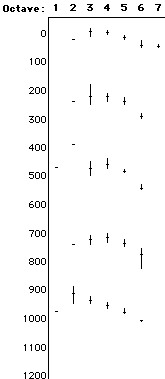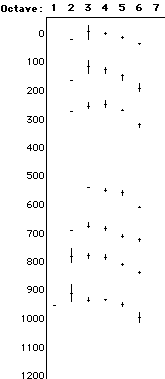
Wasisto Surjodiningrat, P. J. Sudarjana, and Adhi Susanto. Tone Measurements of Outstanding Javanese Gamelans in Yogyakarta and Surakarta. Second Edition. Yogyakarta, Indonesia: Gadjah Mada University Press, 1993. English translation by the authors of Penjelidikan dalam pengukuran nada gamelan-gamelan djawa terkemuka di Jogjakarta dan Surakarta, 1972.
and
Mantle Hood. "Slendro and Pelog Redefined," Selected Reports I/1 (1966):28.
Because these works are copyrighted and available, I have not reproduced the raw data here. Surjodiningrat, Sudarjana, and Susanto measured the pitches of the central octave saron of 76 respected gamelan from Central Java. They also measured all the instruments in a few select gamelan, those shown below. Hood measured all the instruments of Kyahi Mendung, a Solonese gamelan now at UCLA.
I have graphed their data on scales of cents, relative to the average pitch of tone 1 of the middle octave. The different octaves are shown in parallel columns. The range of variation of a particular pitch between instruments is shown by a vertical line spanning that variation. The average pitch between all the instruments measured is shown by a horizontal line. With this arrangement, the octave detunings become clear.
First, here is the slendro gamelan Kyahi Mendung from UCLA:



Finally, here are the slendro and pelog gamelan of the Kraton (Palace) of Yogya, named Kyahi Madukusuma and Kyahi Madumurti, respectively:

